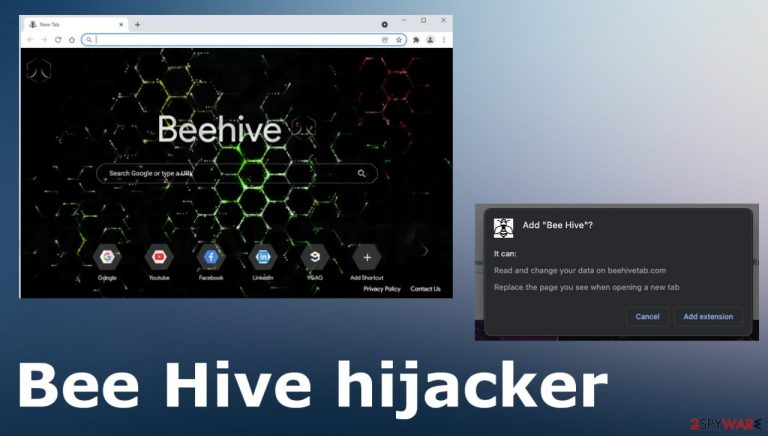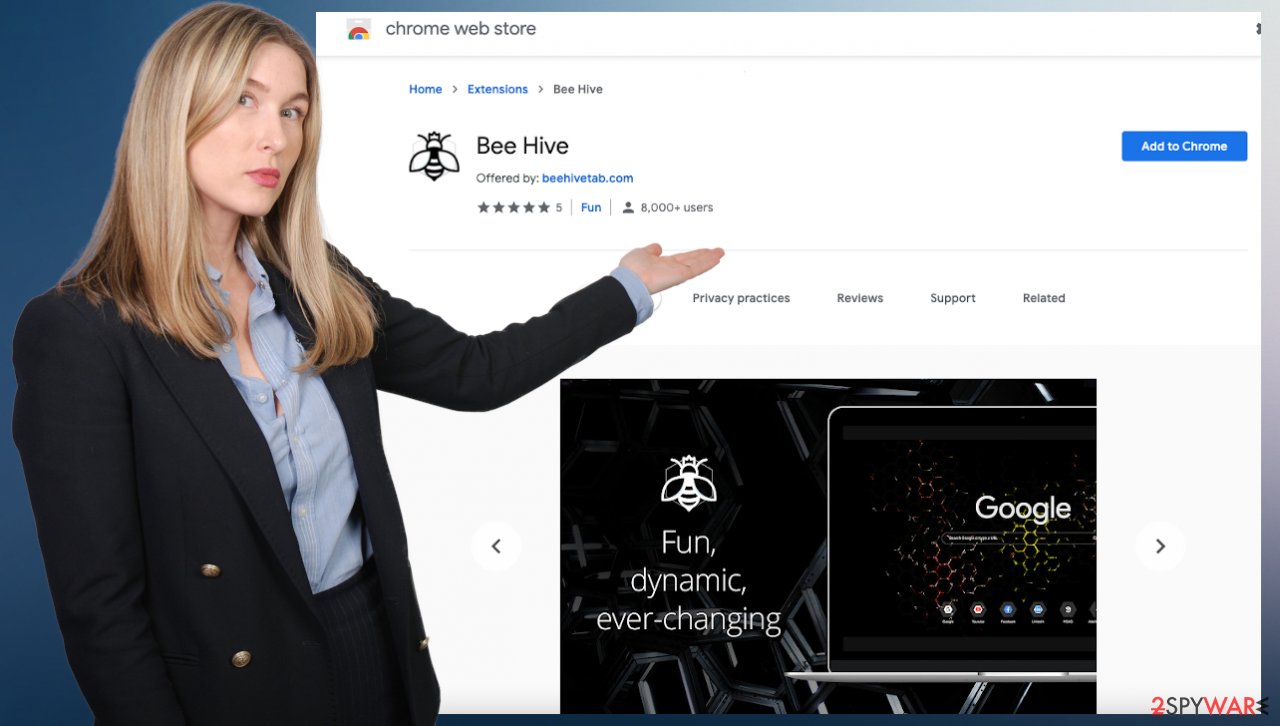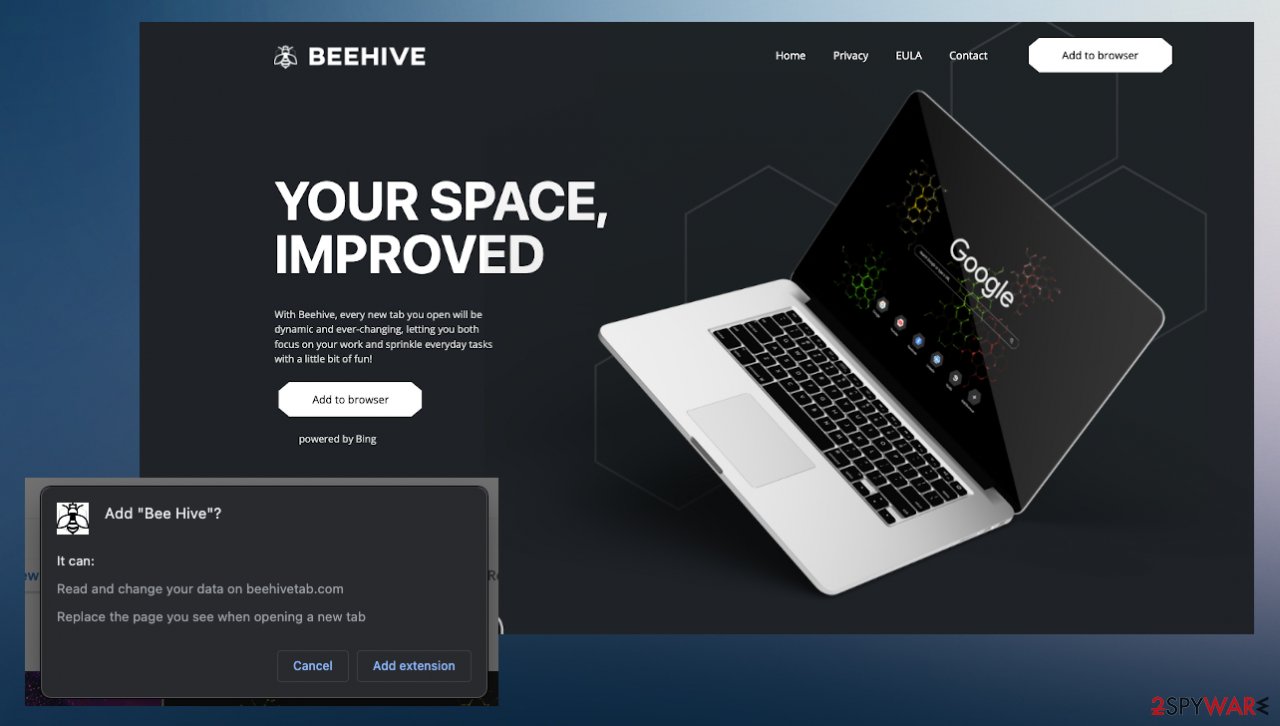Bee Hive Tab browser hijacker (spam) - Simple Removal Guide
Bee Hive Tab browser hijacker Removal Guide
What is Bee Hive Tab browser hijacker?
Bee Hive Tab browser plugin is the application that manipulates browser preferences

Bee Hive Tab is the potentially unwanted program that is considered a browser hijacker for the activities on Google Chrome once it is willingly or unknowingly added. The program is promoted as a customizable new tab page with a great design. However, there are some issues related to the functionalities of the browser-based intruder. Homepage, new tab, default search engine changes, and unwanted ads, commercial content redirects.
Developers of the program promote and advertise the application constantly, so people might even get the browser plugin willingly when the advertisement tricks them into believing that the tool is needed and useful. Unfortunately, the chrome web store even distributes this suspicious browser-based app, and some, possibly false reviews encourage others to get the extension.
The more common way to deliver these applications to machines – software bundling.[1] This is the method borrowed from marketing that allows PUP developers to attach their products to freeware that is popular and often downloaded from internet sources.
Torrent sites, p2p platforms, and pirating services include these programs in the list of other applications, and users cannot control the installation that happens behind the main freeware installation. This is the main issue with the browser-based programs like Bee Hive Tab browser hijacker and PUPs that have gained the name for the intrusive and stealthy behavior.
| NAME | Bee Hive Tab |
| TYPE | Browser hijacker; browser plugin, potentially unwanted program[2] |
| SYMPTOMS | The main settings of the browser get changed, like the homepage, new tab address, and default search engine |
| DISTRIBUTION | Shady websites, software bundling, web stores, pirating services, promotional deceiving ads |
| DANGERS | The extension may lead to dangerous websites; display misinformation, inaccurate search results; track browsing and collecting data, expose users to possibly dangerous online content |
| ELIMINATION | Remove the extension by going to your browser settings, but do not forget to eliminate the PUP manually or with AV tools |
| FURTHER STEPS | Use FortectIntego to fix any remaining damage and optimize the machine |
The infection is common, and users can find the application promoted on various platforms or via other browser hijackers. There are tons of such suspicious search engines that aim to manipulate settings, affect browser performance and behavior of the machine. Bee Hive Tab browser hijacker is only one of many questionable programs that pose as a great addition to Google Chrome applications or other web browsers.

What is the browser hijacker?
This is the intruder that can be mainly found affecting the Chrome browser, but these programs are universal, and there are tons of different pieces like this that can significantly diminish the time online and the process of browsing online sources. These are other common browser hijackers that create issues on the Windows and MacOS machines:
Browser hijackers are modification programs that affect browsers with the purpose of controlling the traffic online. Because search hijackers like this inject sponsored material, advertisements, related content, so the user is searching the web and mostly seeing the advertisements that redirect people to sites where views and visits can be collected.
Sometimes these applications can be difficult to remove and stop because the PUP is not considered malicious and often can run in the background. There are ways to stop the intruder, and anti-malware tools like SpyHunter 5Combo Cleaner or Malwarebytes can help remove the Bee Hive Tab browser hijacker and any related applications. However, you need to properly run through the settings on the particular browser that is affected. In this case, mainly Chrome gets infiltrated.
Take care of the Google Chrome browser
Delete malicious extensions from Google Chrome:
- Open Google Chrome, click on the Menu (three vertical dots at the top-right corner) and select More tools > Extensions.
- In the newly opened window, you will see all the installed extensions. Uninstall all the suspicious plugins that might be related to the unwanted program by clicking Remove.

Clear cache and web data from Chrome:
- Click on Menu and pick Settings.
- Under Privacy and security, select Clear browsing data.
- Select Browsing history, Cookies and other site data, as well as Cached images and files.
- Click Clear data.

Change your homepage:
- Click menu and choose Settings.
- Look for a suspicious site in the On startup section.
- Click on Open a specific or set of pages and click on three dots to find the Remove option.
Reset Google Chrome:
If the previous methods did not help you, reset Google Chrome to eliminate all the unwanted components:
- Click on Menu and select Settings.
- In the Settings, scroll down and click Advanced.
- Scroll down and locate Reset and clean up section.
- Now click Restore settings to their original defaults.
- Confirm with Reset settings.
Ways to avoid unwanted program infiltration
Unfortunately, these potentially unwanted programs have additional issues with the behavior because even experts[3] recommend staying away from the PUPs due to the data tracking issues and collecting personally non-identifiable information. Bee Hive Tab or other adware, browser hijacker applications should state these functions on their sites.
You need to consider possible third-party program installations and tracking functions when you use any unwanted or at least suspicious program. These applications can run in the background and affect more than you think, so removing the PUP and running tools like FortectIntego is important. This way, you can control the damage that this threat or another installation has caused.
The usage of data and tracking cookie usage need to be listed in the Privacy Policy sections. This program and developers of the app state about the data tracking on their site, but ambiguous statements are always deceptive and misleading since PUPs have questionable functions not disclosed with users.
A cookie is a small file placed on Your Device. You can instruct Your browser to refuse all Cookies or to indicate when a cookie is being sent. However, if You do not accept Cookies, You may not be able to use some parts of our Service. Unless you have adjusted Your browser setting so that it will refuse cookies, our Service may use Cookies.

Bee Hive Tab browser hijacker is not a virus, but there are possible issues coming from the long time of the browser-based intruders being active on the device. Due to the nature of the potentially unwanted programs, the infiltration can happen way before the first symptoms, so the victim of such a cyber threat cannot be sure when the installation happened.
However, it is possible to avoid these PUP infiltrations entirely. If you avoid torrent sites, promotional ads, download sites, and random commercial pages, you can stay away from these suspicious and potentially dangerous apps. Choosing trustworthy sources, sites, where the freeware is not pre-bundled could help avoid anything malicious.
Choosing the Advanced or Custom options during the initial installation is the key to avoiding any infiltration like the Bee Hive Tab or PUPs. You can un-select programs from the list when the pre-bundled pack is revealed. Do so every time you install anything and control the downloads yourself.
You may remove virus damage with a help of FortectIntego. SpyHunter 5Combo Cleaner and Malwarebytes are recommended to detect potentially unwanted programs and viruses with all their files and registry entries that are related to them.
Getting rid of Bee Hive Tab browser hijacker. Follow these steps
Uninstall from Windows
Instructions for Windows 10/8 machines:
- Enter Control Panel into Windows search box and hit Enter or click on the search result.
- Under Programs, select Uninstall a program.

- From the list, find the entry of the suspicious program.
- Right-click on the application and select Uninstall.
- If User Account Control shows up, click Yes.
- Wait till uninstallation process is complete and click OK.

If you are Windows 7/XP user, proceed with the following instructions:
- Click on Windows Start > Control Panel located on the right pane (if you are Windows XP user, click on Add/Remove Programs).
- In Control Panel, select Programs > Uninstall a program.

- Pick the unwanted application by clicking on it once.
- At the top, click Uninstall/Change.
- In the confirmation prompt, pick Yes.
- Click OK once the removal process is finished.
Delete from macOS
Remove items from Applications folder:
- From the menu bar, select Go > Applications.
- In the Applications folder, look for all related entries.
- Click on the app and drag it to Trash (or right-click and pick Move to Trash)

To fully remove an unwanted app, you need to access Application Support, LaunchAgents, and LaunchDaemons folders and delete relevant files:
- Select Go > Go to Folder.
- Enter /Library/Application Support and click Go or press Enter.
- In the Application Support folder, look for any dubious entries and then delete them.
- Now enter /Library/LaunchAgents and /Library/LaunchDaemons folders the same way and terminate all the related .plist files.

Remove from Microsoft Edge
Delete unwanted extensions from MS Edge:
- Select Menu (three horizontal dots at the top-right of the browser window) and pick Extensions.
- From the list, pick the extension and click on the Gear icon.
- Click on Uninstall at the bottom.

Clear cookies and other browser data:
- Click on the Menu (three horizontal dots at the top-right of the browser window) and select Privacy & security.
- Under Clear browsing data, pick Choose what to clear.
- Select everything (apart from passwords, although you might want to include Media licenses as well, if applicable) and click on Clear.

Restore new tab and homepage settings:
- Click the menu icon and choose Settings.
- Then find On startup section.
- Click Disable if you found any suspicious domain.
Reset MS Edge if the above steps did not work:
- Press on Ctrl + Shift + Esc to open Task Manager.
- Click on More details arrow at the bottom of the window.
- Select Details tab.
- Now scroll down and locate every entry with Microsoft Edge name in it. Right-click on each of them and select End Task to stop MS Edge from running.

If this solution failed to help you, you need to use an advanced Edge reset method. Note that you need to backup your data before proceeding.
- Find the following folder on your computer: C:\\Users\\%username%\\AppData\\Local\\Packages\\Microsoft.MicrosoftEdge_8wekyb3d8bbwe.
- Press Ctrl + A on your keyboard to select all folders.
- Right-click on them and pick Delete

- Now right-click on the Start button and pick Windows PowerShell (Admin).
- When the new window opens, copy and paste the following command, and then press Enter:
Get-AppXPackage -AllUsers -Name Microsoft.MicrosoftEdge | Foreach {Add-AppxPackage -DisableDevelopmentMode -Register “$($_.InstallLocation)\\AppXManifest.xml” -Verbose

Instructions for Chromium-based Edge
Delete extensions from MS Edge (Chromium):
- Open Edge and click select Settings > Extensions.
- Delete unwanted extensions by clicking Remove.

Clear cache and site data:
- Click on Menu and go to Settings.
- Select Privacy, search and services.
- Under Clear browsing data, pick Choose what to clear.
- Under Time range, pick All time.
- Select Clear now.

Reset Chromium-based MS Edge:
- Click on Menu and select Settings.
- On the left side, pick Reset settings.
- Select Restore settings to their default values.
- Confirm with Reset.

Remove from Mozilla Firefox (FF)
Remove dangerous extensions:
- Open Mozilla Firefox browser and click on the Menu (three horizontal lines at the top-right of the window).
- Select Add-ons.
- In here, select unwanted plugin and click Remove.

Reset the homepage:
- Click three horizontal lines at the top right corner to open the menu.
- Choose Options.
- Under Home options, enter your preferred site that will open every time you newly open the Mozilla Firefox.
Clear cookies and site data:
- Click Menu and pick Settings.
- Go to Privacy & Security section.
- Scroll down to locate Cookies and Site Data.
- Click on Clear Data…
- Select Cookies and Site Data, as well as Cached Web Content and press Clear.

Reset Mozilla Firefox
If clearing the browser as explained above did not help, reset Mozilla Firefox:
- Open Mozilla Firefox browser and click the Menu.
- Go to Help and then choose Troubleshooting Information.

- Under Give Firefox a tune up section, click on Refresh Firefox…
- Once the pop-up shows up, confirm the action by pressing on Refresh Firefox.

Delete from Safari
Remove unwanted extensions from Safari:
- Click Safari > Preferences…
- In the new window, pick Extensions.
- Select the unwanted extension and select Uninstall.

Clear cookies and other website data from Safari:
- Click Safari > Clear History…
- From the drop-down menu under Clear, pick all history.
- Confirm with Clear History.

Reset Safari if the above-mentioned steps did not help you:
- Click Safari > Preferences…
- Go to Advanced tab.
- Tick the Show Develop menu in menu bar.
- From the menu bar, click Develop, and then select Empty Caches.

After uninstalling this potentially unwanted program (PUP) and fixing each of your web browsers, we recommend you to scan your PC system with a reputable anti-spyware. This will help you to get rid of Bee Hive Tab browser hijacker registry traces and will also identify related parasites or possible malware infections on your computer. For that you can use our top-rated malware remover: FortectIntego, SpyHunter 5Combo Cleaner or Malwarebytes.
How to prevent from getting browser plugins
Stream videos without limitations, no matter where you are
There are multiple parties that could find out almost anything about you by checking your online activity. While this is highly unlikely, advertisers and tech companies are constantly tracking you online. The first step to privacy should be a secure browser that focuses on tracker reduction to a minimum.
Even if you employ a secure browser, you will not be able to access websites that are restricted due to local government laws or other reasons. In other words, you may not be able to stream Disney+ or US-based Netflix in some countries. To bypass these restrictions, you can employ a powerful Private Internet Access VPN, which provides dedicated servers for torrenting and streaming, not slowing you down in the process.
Data backups are important – recover your lost files
Ransomware is one of the biggest threats to personal data. Once it is executed on a machine, it launches a sophisticated encryption algorithm that locks all your files, although it does not destroy them. The most common misconception is that anti-malware software can return files to their previous states. This is not true, however, and data remains locked after the malicious payload is deleted.
While regular data backups are the only secure method to recover your files after a ransomware attack, tools such as Data Recovery Pro can also be effective and restore at least some of your lost data.
- ^ M.R. Anglin. What is a Software Bundle?. Easytechjunkie. Technology insights.
- ^ Potentially unwanted program. Wikipedia. The free encyclopedia.
- ^ Lesvirus. Lesvirus. Spyware related news.
